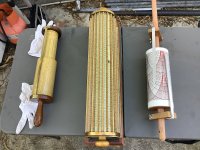Too easy.I got this one from my wife's grandfather. No idea how to use it!
I made it through my Aerospace Eng degree with my highschool Canon scientific calculator, couldn't afford the Texas Instruments fancy one. Well maybe I could have, but that would have meant less beer!
6/pi() = 1.9 approx

